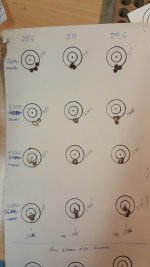Right On !
Jerry,
I decided it was time to switch when i was setting at the bench and I could see my bullets growing. To the point a couple came completely out of the neck sitting on top of the powder. I let Billy shoot the .268 for a year before I switched just to be sure there were no problems. Accuracy wise I dont think theres any difference. A properly turned neck with the correct amount of clearance will shoot equally as good. However the .268 necks will hold a boattail in place where a .262 with the same load cant.
Bart
Good point Bart! Now we're getting to the bottom of the reasons for the trend toward .268 and .269 necks. I'm glad I followed Jackie Schmidt's lead of .269 long ago with my Beggs cartridges. Lately, I've been concentrating on the 6Beggs No-turn with a .274 neck. No neck turning at all!

Hey, I wonder how the 6PPC would work with a .274 No-turn neck? ! Huh?

Me? I'll stick with my 6Beggs no-turn but for those that believe there's something special about the PPC's Ackley body taper and 30 degree shoulder angle, a no-turn 6PPC might be just the thing!

One of Richard Brensing's associates is already doing very well shooting Norma cases no-turn in his 6PPC. I believe he is using a .269 neck. Something to think about; huh?
But of course if you're gonna' continue using Lapua 220 Russian cases as most of us will, you will have to go to at least a .273 neck in order to have the optimum clearance on the loaded round.
And hey; lots of PPC shooters have been living with outdated chamber reamer designs requiring the use of expensive custom sizing dies when now may be the time to upgrade to a new reamer with more desirable dimensions. JGS, PT&G and other reamer manufacturers will just be delighted to help you and the cost of a new reamer is insignificant when compared to other items required by this madness we call benchrest.

For the 6PPC, my specs on a new reamer would be:
* .268 for a tight neck chamber using Lapua brass. .273 for no-turn.
* .4420 dimension'A', (.200 in front of the extractor groove.)
* .4310 at the shoulder before beginning of radius to shoulder angle.
* .040 freebore, .2435 diameter. (can use either flatbase or boattail bullets.)
* Case overall length (base to end of neck) 1.510.
* Of course, one and a half degree leade angle.
Let's see what everyone thinks of this; huh?

Later,
Gene Beggs


